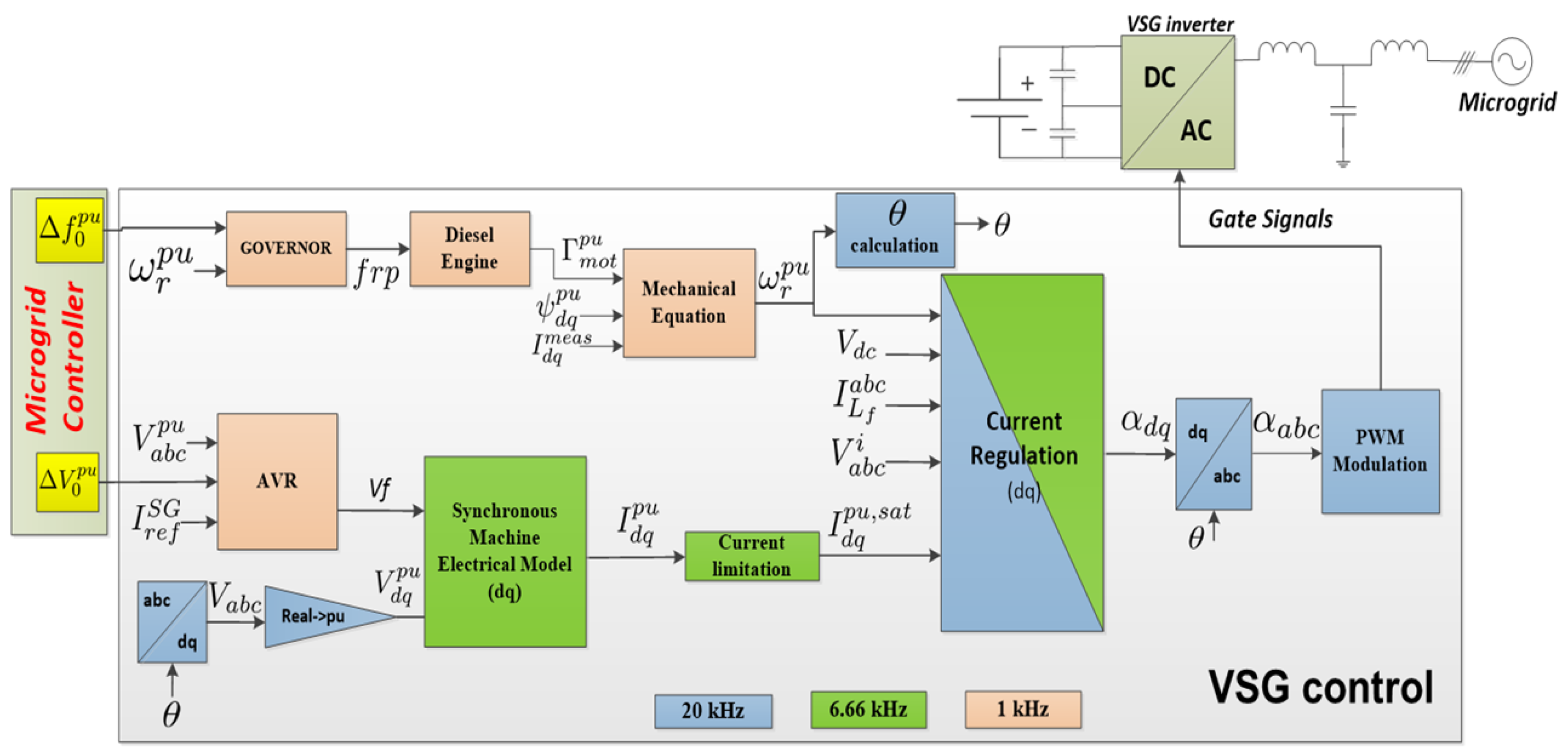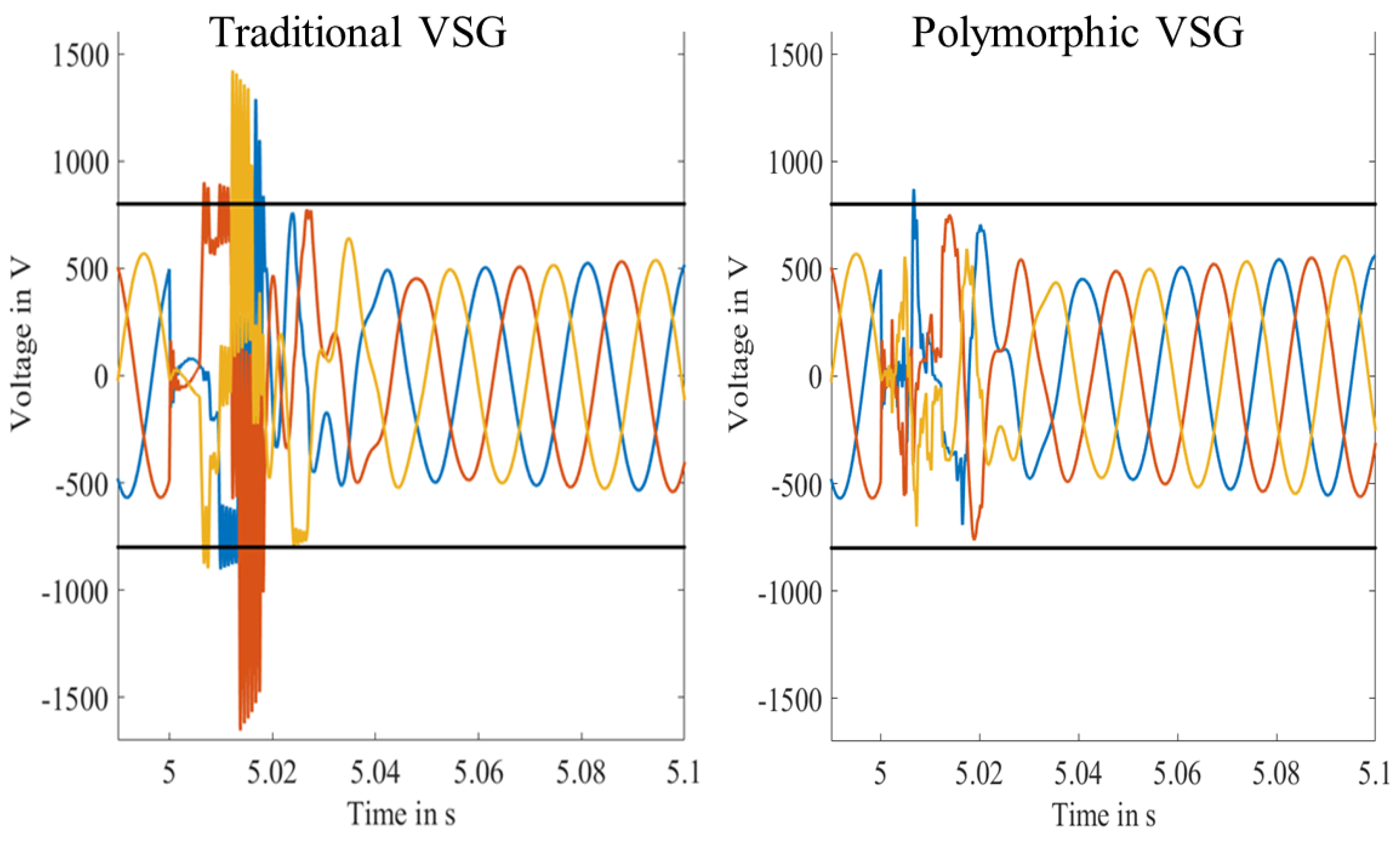Polymorphic Virtual Synchronous Generator: An Advanced Controller for Smart Inverters
Abstract
:1. Introduction
2. Analytic Model of the Polymorphic VSG
2.1. A Polymorphic VSG
- Given the current state of the system, an optimal sequence of parameters is obtained by formulating a constrained optimization problem whose cost function and constraint penalties on the satisfaction and quality of the regulation are expressed in Section 2.2;
- The optimal sequence is found using a nonlinear programming solver since the optimization of the parameters is not linear;
- The corresponding values of the VSG parameters are assigned to the system over the sampling period;
- At the beginning of the next sampling period, the new optimization problem is defined given the new value of the state vector. This process continues indefinitely leading to state feedback.
2.2. Analytical Model
2.2.1. State-Space Model
2.2.2. Optimization
- The inverter output currents, and ;
- The inverter output voltages, and ;
- The inverter duty ratio, and .
2.3. The Behavior of the Polymorphic VSG
3. Integrating the Polymorphic VSG Controller in Industrial Inverters
3.1. Regression Models for Optimal Solutions
- Recuperation of 50% of the polymorphic VSG data during the stage presented in Section 4.1;
- Removing the data if the parameter is equal to the reference value;
- Permutation and mix of the data vector to remove any temporal relationship;
- Regression model based on the raw data depending on the selected regression algorithm;
- Or regression model with ST and PCA:
- (a)
- Determination of the ST coefficients: centering means and variances;
- (b)
- Determination of the PCA matrices;
- (c)
- Determination of the regression model based on the ST and PCA inputs depending on the selected regression algorithm;
- Then, the regression models are validated:
- (a)
- Validation on the other half of the data vector;
- (b)
- Integration on the VSG controller and simulation of the scenarios defined in Section 4.1.
3.2. Finite Set of Admissible Parameters
4. Comparison with Reference Solution
- Maximum duty ratio p.u.;
- Maximum voltage magnitude V;
- Maximum current magnitude A.
4.1. Scenarios Definition
4.1.1. Short-Circuits
4.1.2. Harsh Load Variations
4.2. Feasibility
4.3. Results and Comparison
5. Discussion
6. Conclusions
7. Patents
Author Contributions
Funding
Data Availability Statement
Conflicts of Interest
Abbreviations
| and | Machine dq stator flux linkages |
| Machine rotor flux linkage | |
| Machine rotor electrical angular velocity | |
| and | Machine dq stator output current |
| Machine d-axis excitation voltage | |
| Machine stator line (armature) resistance | |
| and | Machine dq stator-rotor inductance |
| Machine d-axis transient | |
| Machine d-axis transient open-circuit time | |
| and | dq inverter duty ratio |
| and | Single-line and dq filter voltage |
| and | dq grid voltage |
| and | dq output inverter current |
| and | dq grid inverter current |
| Full zeros matrix of i rows and j colons | |
| Matrix of i lines and j columns | |
| Transposed matrix of M | |
| Observed matrix M | |
| Next step state-space value of M | |
| Reference of the state vector M |
References
- Hoke, A.; Butler, R.; Hambrick, J.; Kroposki, B. Steady-State Analysis of Maximum Photovoltaic Penetration Levels on Typical Distribution Feeders. IEEE Trans. Sustain. Energy 2013, 4, 350–357. [Google Scholar] [CrossRef]
- Driesen, J.; Visscher, K. Virtual synchronous generators. In Proceedings of the IEEE Power and Energy Society General Meeting (PESGM), Pittsburgh, PA, USA, 20–24 July 2008; pp. 1–3. [Google Scholar] [CrossRef]
- D’Arco, S.; Suul, J.A.; Fosso, O.B. A Virtual Synchronous Machine Implementation for Distributed Control of Power Converters in Smartgrids. Electr. Power Syst. Res. 2015, 122, 180–197. [Google Scholar] [CrossRef]
- Bevrani, H.; Ise, T.; Miura, Y. Virtual Synchronous Generators: A Survey and New Perspectives. Int. J. Electr. Power Energy Syst. 2014, 54, 244–254. [Google Scholar] [CrossRef]
- Wang, Z.; Yi, H.; Wu, J.; Zhuo, F.; Wang, F.; Zeng, Z. Dynamic Performance Analysis of Paralleled Virtual Synchronous Generators under Grid-connected and Islanded Mode. In Proceedings of the IEEE Applied Power Electronics Conference and Exposition (APEC), Tampa, FL, USA, 26–30 March 2017; pp. 1326–1332. [Google Scholar] [CrossRef]
- Subramanian, L.; Debusschere, V.; Gooi, H.B.; Hadjsaid, N. A Distributed Model Predictive Control Framework for Grid-friendly Distributed Energy Resources. IEEE Trans. Sustain. Energy 2021, 12, 727–738. [Google Scholar] [CrossRef]
- Torres, L.M.A.; Lopes, L.A.C.; Morán T., L.A.; Espinoza, J.R. Self-Tuning Virtual Synchronous Machine: A Control Strategy for Energy Storage Systems to Support Dynamic Frequency Control. IEEE Trans. Energy Convers. 2014, 29, 833–840. [Google Scholar] [CrossRef]
- Hu, Y.; Wei, W.; Peng, Y.; Lei, J. Fuzzy Virtual Inertia Control for Virtual Synchronous Generator. In Proceedings of the Chinese Control Conference (CCC), Chengdu, China, 27–29 July 2016; pp. 8523–8527. [Google Scholar] [CrossRef]
- Alipoor, J.; Miura, Y.; Ise, T. Power System Stabilization Using Virtual Synchronous Generator with Alternating Moment of Inertia. IEEE J. Emerg. Sel. Top. Power Electron. 2015, 3, 451–458. [Google Scholar] [CrossRef]
- Yu, M.; Roscoe, A.J.; Booth, C.D.; Dysko, A.; Ierna, R.; Zhu, J.; Grid, N.; Urdal, H. Use of an Inertia-less Virtual Synchronous Machine within Future Power Networks with High Penetrations of Converters. In Proceedings of the Power Systems Computation Conference (PSCC), Genoa, Italy, 20–24 June 2016; pp. 1–7. [Google Scholar] [CrossRef]
- Ackermann, T.; Prevost, T.; Vittal, V.; Roscoe, A.J.; Matevosyan, J.; Miller, N. Paving the Way: A Future without Inertia Is Closer Than You Think. IEEE Power Energy Mag. 2017, 15, 61–69. [Google Scholar] [CrossRef]
- Li, D.; Zhu, Q.; Lin, S.; Bian, X.Y. A Self-adaptive Inertia and Damping Combination Control of VSG to Support Frequency Stability. IEEE Trans. Energy Convers. 2017, 32, 397–398. [Google Scholar] [CrossRef]
- Kerdphol, T.; Rahman, F.S.; Watanabe, M.; Mitani, Y.; Turschner, D.; Beck, H. Enhanced Virtual Inertia Control Based on Derivative Technique to Emulate Simultaneous Inertia and Damping Properties for Microgrid Frequency Regulation. IEEE Access 2019, 7, 14422–14433. [Google Scholar] [CrossRef]
- Liu, J.; Miura, Y.; Bevrani, H.; Ise, T. Enhanced Virtual Synchronous Generator Control for Parallel Inverters in Microgrids. IEEE Trans. Smart Grid 2017, 8, 2268–2277. [Google Scholar] [CrossRef]
- Shi, R.; Zhang, X.; Hu, C.; Xu, H.; Gu, J.; Cao, W. Self-tuning Virtual Synchronous Generator Control for Improving Frequency Stability in Autonomous Photovoltaic-Diesel Microgrids. J. Mod. Power Syst. Clean Energy 2018, 6, 482–494. [Google Scholar] [CrossRef]
- Wang, X.; Dong, X.; Niu, X.; Zhang, C.; Cui, C.; Huang, J.; Lin, P. Toward Balancing Dynamic Performance and System Stability for DC Microgrids: A New Decentralized Adaptive Control Strategy. IEEE Trans. Smart Grid 2022, 13, 3439–3451. [Google Scholar] [CrossRef]
- Rohten, J.A.; Silva, J.J.; Muñoz, J.A.; Villarroel, F.A.; Dewar, D.N.; Rivera, M.E.; Espinoza, J.R. A Simple Self-Tuning Resonant Control Approach for Power Converters Connected to Micro-Grids With Distorted Voltage Conditions. IEEE Access 2020, 8, 216018–216028. [Google Scholar] [CrossRef]
- Mayne, D.Q.; Rawlings, J.B.; Rao, C.V.; Scokaert, P.O.M. Constrained Model Predictive Control: Stability and Optimality. Automatica 2000, 36, 789–814. [Google Scholar] [CrossRef]
- Moulichon, A.; Garbuio, L.; Debusschere, V.; Rahmani, M.A.; Hadj-Said, N. A Simplified Synchronous Machine Model for Virtual Synchronous Generator Implementation. In Proceedings of the IEEE Power and Energy Society General Meeting (PESGM), Atlanta, GA, USA, 4–8 August 2019; pp. 1–5. [Google Scholar] [CrossRef]
- Moulichon, A.; Alamir, M.; Debusschere, V.; Garbuio, L.; Rahmani, M.A.; Wang, M.X.; Hadjsaid, N. Observer-based Current Controller for Virtual Synchronous Generator in Presence of Unknown and Unpredictable Loads. IEEE Trans. Power Electron. 2020, 36, 1708–1716. [Google Scholar] [CrossRef]
- Andersson, J.A.E.; Gillis, J.; Horn, G.; Rawlings, J.B.; Diehl, M. CasADi—A Software Framework for Nonlinear Optimization and Optimal Control. Math. Program. Comput. 2019, 11, 1–36. [Google Scholar] [CrossRef]
- Issa, H.; Debusschere, V.; Garbuio, L.; Lalanda, P.; Hadjsaid, N. Artificial Intelligence-Based Controller for Grid-Forming Inverter-Based Generators. In Proceedings of the IEEE PES Innovative Smart Grid Technologies Conference (ISGT–Europe), Novi Sad, Serbia, 10–12 October 2022; pp. 1–6. [Google Scholar] [CrossRef]





| SM Parameter | Nominal Value | Polymorphic Parameter | Value |
|---|---|---|---|
| 1.93 p.u. | Control frequency | 1000 Hz | |
| 0.154 p.u. | Steps of prediction horizon | 20 | |
| 1.16 p.u. | Prediction horizon time | 1 ms | |
| 0.11 p.u. | 10 | ||
| 1000 ms | 1100 |
| Parameter | Total Number of Values | Number of Different Values | Percentage |
|---|---|---|---|
| 9696 | 7701 | ∼79% | |
| 31,667 | 23,610 | ∼75% | |
| 17,596 | 11,290 | ∼64% | |
| 1 | 0 | 0% | |
| 1 | 0 | 0% |
| Quantity | Dynamic Optimization | Regression | Regression + ST + PCA | Enumeration of a Finite Set |
|---|---|---|---|---|
| Current | −21.1% | +1% | −2.7% | −31.7% |
| Voltage | −100% | +3.6% | +78.6% | −64.4% |
| Duty ratio | −78.9% | +43.4% | +75.9% | −47.9% |
| Traditional VSG | Dynamic Optimization | Regression | Regression + ST + PCA | Enumeration of a Finite Set | |
|---|---|---|---|---|---|
| Simulation | 7 min | 4 h 3 min | 8 min | 8 min | 12 min |
| Block unit | N.A. | 1880 s | 8 s | 8 s | 40 s |
| Add. CPU load | N.A. | 189% | 1% | 1% | 4% |
Disclaimer/Publisher’s Note: The statements, opinions and data contained in all publications are solely those of the individual author(s) and contributor(s) and not of MDPI and/or the editor(s). MDPI and/or the editor(s) disclaim responsibility for any injury to people or property resulting from any ideas, methods, instructions or products referred to in the content. |
© 2023 by the authors. Licensee MDPI, Basel, Switzerland. This article is an open access article distributed under the terms and conditions of the Creative Commons Attribution (CC BY) license (https://creativecommons.org/licenses/by/4.0/).
Share and Cite
Moulichon, A.; Alamir, M.; Debusschere, V.; Garbuio, L.; Hadjsaid, N. Polymorphic Virtual Synchronous Generator: An Advanced Controller for Smart Inverters. Energies 2023, 16, 7075. https://doi.org/10.3390/en16207075
Moulichon A, Alamir M, Debusschere V, Garbuio L, Hadjsaid N. Polymorphic Virtual Synchronous Generator: An Advanced Controller for Smart Inverters. Energies. 2023; 16(20):7075. https://doi.org/10.3390/en16207075
Chicago/Turabian StyleMoulichon, Audrey, Mazen Alamir, Vincent Debusschere, Lauric Garbuio, and Nouredine Hadjsaid. 2023. "Polymorphic Virtual Synchronous Generator: An Advanced Controller for Smart Inverters" Energies 16, no. 20: 7075. https://doi.org/10.3390/en16207075
APA StyleMoulichon, A., Alamir, M., Debusschere, V., Garbuio, L., & Hadjsaid, N. (2023). Polymorphic Virtual Synchronous Generator: An Advanced Controller for Smart Inverters. Energies, 16(20), 7075. https://doi.org/10.3390/en16207075






